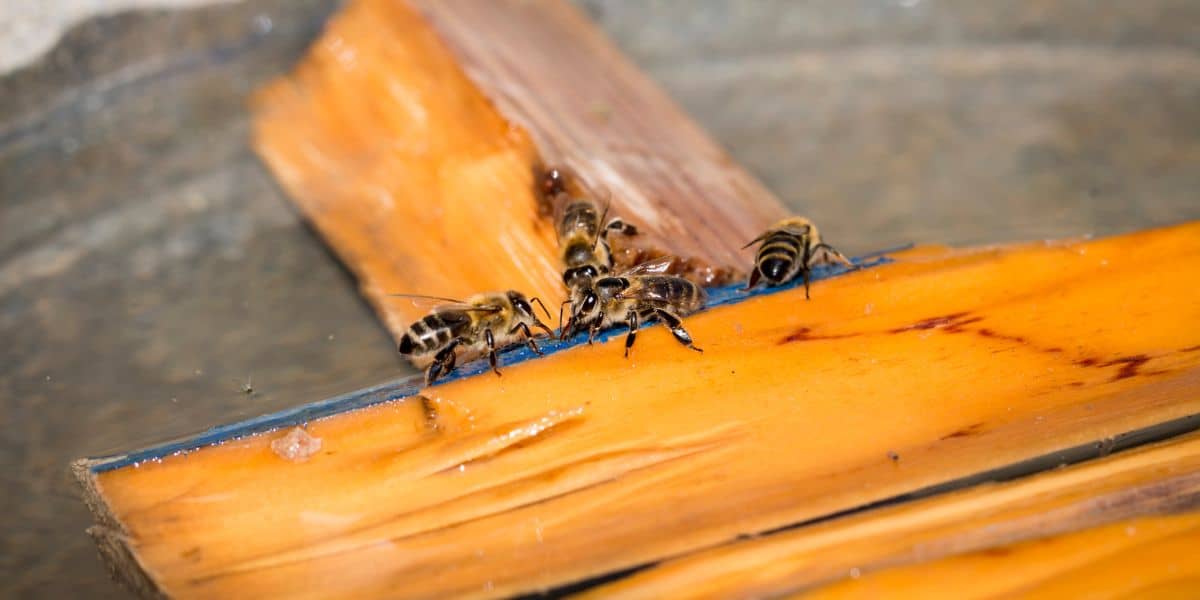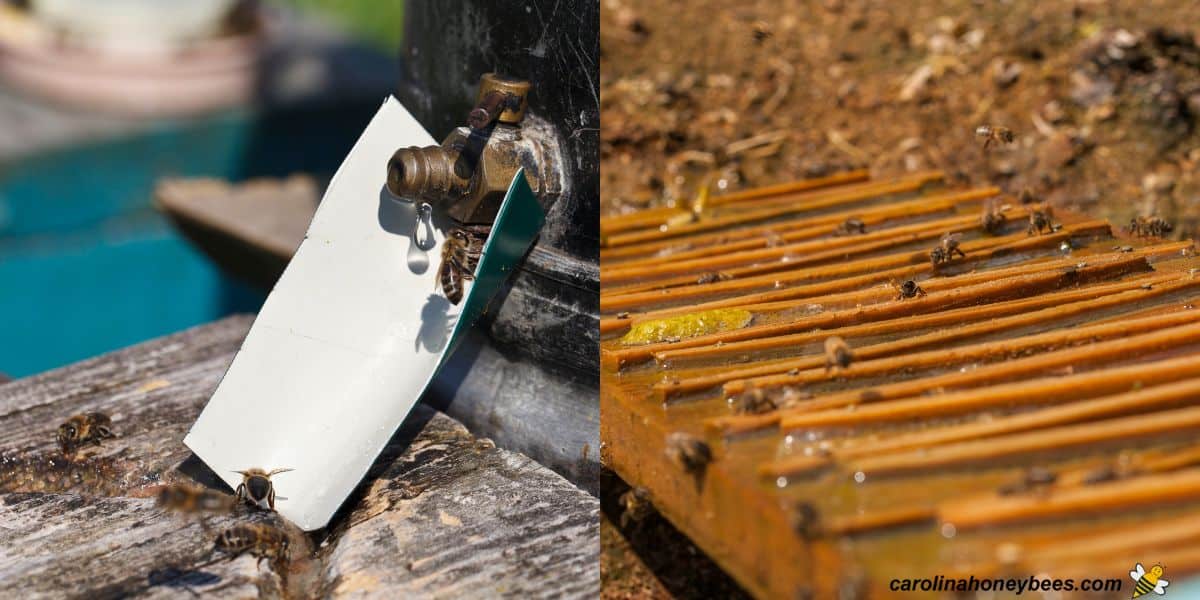Water for Bees
We often see bees collecting nectar and pollen from blooming flowers. But, there is another important resource they need: safe drinking water for bees. Whether you are a beekeeper, gardener or just a bee-lover – you can provide a safe clean water source for honey bees and other pollinators. Bees need water all season long. But, it is especially important in hot weather. Here, I will share some easy ways to help thirsty bees.

A water source for their beehives should be a top consideration for any beekeeper during setting up the bee yard. Likewise, the gardener striving to create a bee oasis need to consider adding a water feature in the design.
Bee Water Needs and Challenges
As most living things, bees need water for hydration. Honey bees rely on water to cool the hive during hot weather and to maintain the proper humidity level for developing young.
Water is not stored in the beehive – it must be collected as needed. This presents some serious challenges.
Bees must compete with other wildlife, including birds, insects, and mammals, for access to water sources such as puddles, streams, and ponds.
Distance plays a role too. Honey bees travel long distances to collect needed resources. The farther the bee must fly for water – the less time and energy they have for other tasks.
Also, contamination is a risk. Human activities introduce pollutants and contaminants into water sources that may pose a risk to bee health.

Good Water Source For Bees
Beekeepers develop some ingenious ways to provide bees with drinking water. Thankfully, many of these ideas work well for the homeowner or gardener who wants to help save important bees and pollinators.
2 Major Considerations
There are 2 things you must keep in mind when creating a water source:
- provide safe places to drink – honey bees are notorious for drowning
- the water source should be consistent – holding water most of the time
Prevent Drowning Bees
Honey bees can do many miraculous things. Unfortunately, one thing they do well is drown – especially if the water is cool.
Honey bees do not have lungs – their respiratory system is different. If they fall into the water, they can close the spiracles (ports where air enters the body) but this is only effective for a short time. Eventually they will die.
Create safe places for visiting bees to drink. Include shallow areas where they can sip water without falling in.
Rocks, sand or pebbles along the waters edge are a good option. Concrete tubs often have rough surfaces for bees to grab.
Vegetation such as water lily pads are also a good choice. If using open buckets of water – place some small pieces of wood that float.

Dependable Bee Water Sources
Consistency is crucial – especially for beekeepers with beehives. Small water sources are easy to create but they require a lot more maintenance. It takes some discipline to remember to check any small water source – every day or twice a day.
The same problems applies to small fountains, buckets, etc. When hot weather arrives and when water is even more important, will you be able to remember to refill?
Creating Bee Friendly Water Sources
Here are some of my favorite ways to give water to bees. Some are quick and simple – well suited for a small garden project. Others are larger enough to fit the needs of a backyard beekeeper.
- create a small water garden
- shallow bird bath with pebbles or rock
- plastic tubs or buckets with floating material
- spouted bucket or barrel with drip
- water feeders for bees
- small water features for gardens

Water Gardens or Small Ponds
My favorite way to provide drinking water for bees is with a water garden. I love mine and have had them for many years – even before I had honey bees. This is something almost any homeowner or homesteader can do.
A small pond of 100-200 gallons in size provides a lot of water. You still need to manage the water level but it is a weekly chore rather than daily.
As an added benefit, plant choice flowers for honey bees around the pond area. Remember to include a shallow place for the bees to drink without fear of drowning.
A small pool with some plants and a few goldfish can be an educational and entertaining addition to any backyard. You could even jump in if you don’t mind swimming with the frogs and fishes.
Bird Baths
Bird baths can be a good water source for bees. But, be prepared for a lot of visiting bees during hot weather – if you have beehives on your property.
The old concrete types have rougher surfaces for bees to grip. The new plastic models need some rock placed just inside the basin for bee safety.
Tubs and Buckets
If you have a medium sized plastic tub or even a 5 gallon bucket, these work well for watering bees. You will need some floating material to prevent drowning.
Popular materials are: small pieces of wood, packing peanuts, slices of those pool noodles, floating baffles that fit inside (a bucket lid with the rim cut off and some holes drilled in the flat lid material.)

Water Dripping from Spout
In “out-yards” where beekeepers have hives with no access to a faucet. They may fill a large bucket or barrel with water and attach a faucet. The faucet is opened just enough to cause a slow drip.
It will take many days for the barrel to empty. The beekeeper will refill it before it is empty. Now, the hives in a remote area have a safe drinking source.

Water Feeders for Bees
You can buy water feeders for bees – but then you can buy just about anything if you have the money. A poultry waterer works well for bee water.
Beekeepers can use mason jar feeders for water instead of sugar water. A vast improvement if you plan to hang them on the front of the hive. Just fill the jars with water and refill as needed.
Small Garden Water Features
For the gardener, several small water features can provide pollinators with water. These units do not hold very much and should be check daily.
One simple option is this clay pot bee watering station. It is small but refilling daily in a shady part of the yard is not too hard. It can also be a pretty addition to your garden decor.
Another small project – this jeweled saucer bee waterer can provide some hydration for insects. And, it is a good opportunity to teach kids about the importance of bees. It is so simple even the youngest can participate with supervision.
Water for Neighborhood Bees
Beekeepers living in crowded neighborhoods have special concerns. One of the best reasons to provide bees with drinking water – your neighbor has a swimming pool ! And yes, they like salt water pools even better.
Be a good neighbor, set up nearby water sources before your bees arrive and try to keep your bees out of their swimming pool. Bees will sometimes visit the outside dog water bowls or fountains of close neighbors. Make it so they don’t have to do this.
Safe Water for City Bees
For urban beekeepers, a natural water supply may be more difficult for your bees to find. Runoff water is often contaminated with fertilizers and other lawn care products. Keep them near home for water.
Foraging bees are less likely to come into contact with contamination by pesticides or other chemicals if they stay in your yard. A consistent water source with a safe place to drink is especially important in warm months.

FAQs
Bees need water for hydration. Honey bees also use water for several uses in the hive – including cool the inside on hot summer days.
Yes, bees and wasps do drink water. In the case of honey bees, they collect water and take it back to the hive.
Yes, there is not reason no to help a thirsty bee. This is especially true if you live in areas without a lot of natural water sources.
Place safe landing spots for bees to collect water. Rocks, pebbles or floating materials are perfect.
Honestly, bees like dirty water. They will sometimes choose a mud puddle or ditch over a provided source. Don’t worry over much about algae or other natural substances in your bees drinking water.
Bees can and do drink pool water. They love chlorine and seem to especially like salt water pools or hot tubs. In spite of the chemicals in pool water, there is little danger in it harming your bees. Much of the water in the hive is used for cooling etc anyway.
Final Thoughts
Providing clean drinking water for bees can be fun and beautiful. Both small and larger features contribute to good pollinator health. Healthy bees are productive bees.

